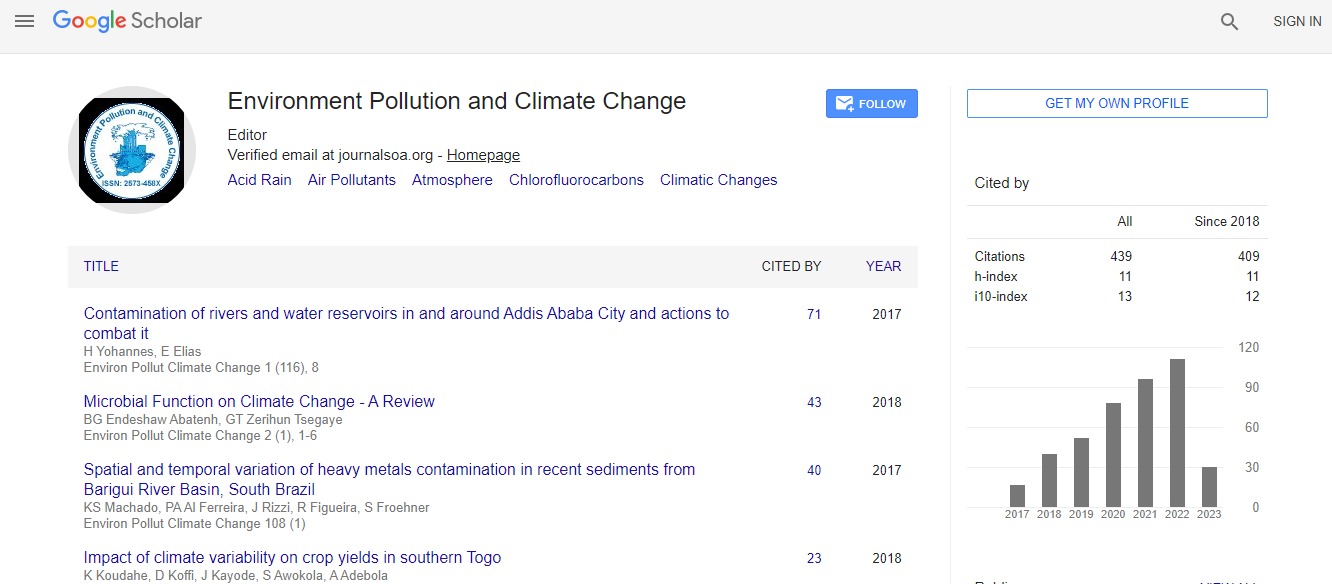Our Group organises 3000+ Global Conferenceseries Events every year across USA, Europe & Asia with support from 1000 more scientific Societies and Publishes 700+ Open Access Journals which contains over 50000 eminent personalities, reputed scientists as editorial board members.
Open Access Journals gaining more Readers and Citations
700 Journals and 15,000,000 Readers Each Journal is getting 25,000+ Readers
Google Scholar citation report
Citations : 431
Environment Pollution and Climate Change received 431 citations as per Google Scholar report
Environment Pollution and Climate Change peer review process verified at publons
Indexed In
- Google Scholar
- Publons
- Euro Pub
- ICMJE
Useful Links
Recommended Journals
Share This Page
Towards a sustainable chemical future
Joint Event on 5th World Conference on Climate Change & 16th Annual Meeting on Environmental Toxicology and Biological Systems
Edwin John Routledge
Brunel University London, UK
Keynote: Environ Pollut Climate Change
Abstract
Since the start of the industrial revolution, society has become increasingly reliant on the use of chemicals, including pesticides, pharmaceuticals, plasticizers and personal care products, to name a few. In 2016, European chemical sales alone were valued at 507 billion Euros, with 80,000 chemicals reported to be in common use worldwide. Alongside the many benefits of chemicals to society, concerns about the impacts of certain chemicals to both human and wildlife health, including the so-called ‘endocrine disrupting chemicals’ is a topic of increasing concern. Since the term ‘endocrine disruptor’ was coined in 1991, extensive research into the effects of various chemicals, and chemical mixtures, on human and wildlife health has been conducted globally. More than 1,300 studies have suggested connections between endocrine-disrupting chemical (EDC) exposure and serious health conditions such as infertility, diabetes, obesity, hormone-related cancers and neurological disorders in humans. The range of endocrine targets captured by regulatory tests is expanding rapidly, and new mechanistic insights, such as epigenetic mechanisms of chemical-induced disease, continue to challenge the regulatory frameworks designed to protect society and the environment. Difficulties still exist in balancing the trade-offs between the benefits of chemicals to society at point of use with the burden of proof needed to demonstrate the adverse consequences of the same chemicals once they are allowed to disperse in the environment. When dealing with such complexity, is it possible to achieve a vision of a sustainable society where chemicals are managed carefully throughout their lifecycle and where people benefit from their use and thrive within nature’s limits? What strategies and insights can sustainability science offer to help society balance the Tox-Eco system? Recent Publications 1. Kaur S, Jobling S, Jones CS, Noble LR, Routledge EJ, Lockyer AE (2015) The Nuclear Receptors of Biomphalaria glabrata and Lottia gigantea: Implications for Developing New Model Organisms. PLOS One 10(4): UNSP e0121259. 2. Bannister R, Beresford N, Granger DW, Pounds NA, Rand-Weaver M, White R, Jobling S, Routledge EJ (2013) No substantial changes in estrogen receptor and estrogen-related receptor orthologue gene transcription in Marisa cornuarietis exposed to estrogenic chemicals. Aquatic Toxicology 140: 19-26. 3. Routledge EJ, White R, Parker MG, Sumpter JP (2000) Differential effects of xenoestrogens on coactivator recruitment by estrogen receptor (ER) alpha and ER beta. Journal of Biological Chemistry 275(46): 35986-35993. 4. Routledge EJ, Parker J, Odum J, Ashby J, Sumpter JP (1998) Some alkyl hydroxy benzoate preservatives (parabens) are estrogenic. Toxicology and Applied Pharmacology 153(1): 12-19. 5. Routledge EJ & Sumpter JP (1996) Estrogenic activity of surfactants and some of their degradation products assessed using a recombinant yeast screen. Environmental Toxicology and Chemistry 15(3): 241-248.Biography
Edwin John Routledge is an Environmental Scientist whose research is concerned with understanding the effects of environmental chemicals (particularly endocrine disrupting chemicals) on aquatic wildlife. His research interest is broadly in the field of water quality. It started with investigations into endocrine disrupting chemicals and their effects on fish and amphibians, and more recently includes the effects of EDCs on molluscs. Current research (mostly unpublished) is concerned with new and emerging threats, including chemicals that impact on the retinoid system, and how chemical exposures might alter disease transmission in parasite-host interactions.
E-mail: edwin.routledge@brunel.ac.uk

 Spanish
Spanish  Chinese
Chinese  Russian
Russian  German
German  French
French  Japanese
Japanese  Portuguese
Portuguese  Hindi
Hindi 
